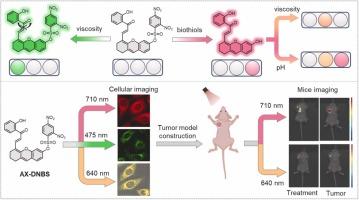Fluorescent probe for tumor imaging and prognostic assessment via multi-response to biothiols, viscosity, and pH values
IF 8
1区 化学
Q1 CHEMISTRY, ANALYTICAL
引用次数: 0
Abstract
Accurate tumor diagnosis and drug efficacy assessment are crucial aspects of cancer treatment. Tumor cells typically display aberrant levels of biothiols, higher viscosity, and lower acidity compared to normal cells. Thus, precise monitoring of biothiol levels in the intricate cellular environment is essential for early tumor detection. We have developed a novel near-infrared (NIR) fluorescence probe AX-DNBS for the simultaneous detection of biothiols, viscosity, and pH through multi-channel imaging. With the treatment of biothiol, AX-DNBS triggers the release of AX-OH, resulting in enhanced fluorescence emission at 710 nm. Both AX-DNBS and AX-OH exhibit sensitive responses to changes in viscosity, with fluorescence emissions at 475 nm and 640 nm, respectively. In the pH range of 3–10, an increase in alkalinity leads to a ratiometric fluorescence signal of AX-OH with a significant emission red-shift from 640 nm to 710 nm. Significantly, in subsequent biological trials, AX-DNBS proved effective in monitoring alterations in biothiol levels, viscosity, and pH within live cells, facilitating the diagnosis of tumors and the evaluation of the therapeutic effects of paclitaxel in tumor mice models.

通过对生物硫醇、粘度和 pH 值的多重响应进行肿瘤成像和预后评估的荧光探针
准确的肿瘤诊断和药物疗效评估是癌症治疗的关键环节。与正常细胞相比,肿瘤细胞通常显示出异常的生物硫醇水平、较高的粘度和较低的酸度。因此,精确监测错综复杂的细胞环境中的生物硫醇水平对于早期肿瘤检测至关重要。我们开发了一种新型近红外(NIR)荧光探针 AX-DNBS,可通过多通道成像同时检测生物硫醇、粘度和酸碱度。在处理生物硫醇时,AX-DNBS 会触发 AX-OH 的释放,从而增强 710 纳米波长处的荧光发射。AX-DNBS 和 AX-OH 对粘度的变化都表现出敏感的反应,分别在 475 纳米和 640 纳米处发出荧光。在 pH 值为 3-10 的范围内,碱度的增加会导致 AX-OH 的荧光信号从 640 纳米显著红移到 710 纳米。值得注意的是,在随后的生物试验中,AX-DNBS 被证明能有效监测活细胞内生物硫醇水平、粘度和 pH 值的变化,有助于诊断肿瘤和评估肿瘤小鼠模型中紫杉醇的治疗效果。
本文章由计算机程序翻译,如有差异,请以英文原文为准。
求助全文
约1分钟内获得全文
求助全文
来源期刊

Sensors and Actuators B: Chemical
工程技术-电化学
CiteScore
14.60
自引率
11.90%
发文量
1776
审稿时长
3.2 months
期刊介绍:
Sensors & Actuators, B: Chemical is an international journal focused on the research and development of chemical transducers. It covers chemical sensors and biosensors, chemical actuators, and analytical microsystems. The journal is interdisciplinary, aiming to publish original works showcasing substantial advancements beyond the current state of the art in these fields, with practical applicability to solving meaningful analytical problems. Review articles are accepted by invitation from an Editor of the journal.
 求助内容:
求助内容: 应助结果提醒方式:
应助结果提醒方式:


